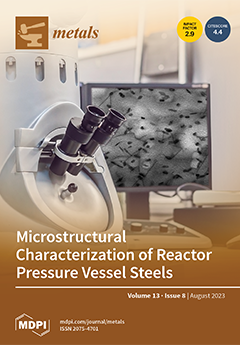For the purpose of determining the interaction parameters between Mn and Al, and the influence of Mn on Al
2O
3 inclusions formation in the Fe-Mn-Al-O melts with high Mn and Al contents, three groups of Fe-Mn-Al-O melts with the initial Al
[...] Read more.
For the purpose of determining the interaction parameters between Mn and Al, and the influence of Mn on Al
2O
3 inclusions formation in the Fe-Mn-Al-O melts with high Mn and Al contents, three groups of Fe-Mn-Al-O melts with the initial Al content of 3, 5, and 7 mass% and different Mn contents were equilibrated with pure solid Al
2O
3 in an Al
2O
3 crucible at 1873 K and Ar-H
2 atmosphere. Then, the interaction parameters between Mn and Al were deduced using the WIPF (Wagner’s Interaction Parameter Formalism) and the R-K polynomial (Redlich-Kister type polynomial), respectively. From the WIPF, the first- and second-order interaction parameters,
and
, were determined to be 0.0292 and −0.00016, respectively. From the R-K polynomial, the binary interaction parameters,
and
, were determined to be 73,439 J/mol and −34,919 J/mol, respectively. The applicability of the WIPF to high Mn and Al content Fe-Mn-Al-O melts was investigated by comparing the Al activity calculated by the WIPF and the R-K polynomial using the obtained data. The results showed that WIPF can be used in high Mn and Al content melts in the current concentration range. Further from the iso-activity contours of Al, the activity of Al increases with increasing Al or Mn content. Finally, the thermodynamic calculations show that the addition of Mn decreases the equilibrium O content at the same Al content, making the formation of Al
2O
3 inclusions easier.
Full article
 to open them.
to open them.




